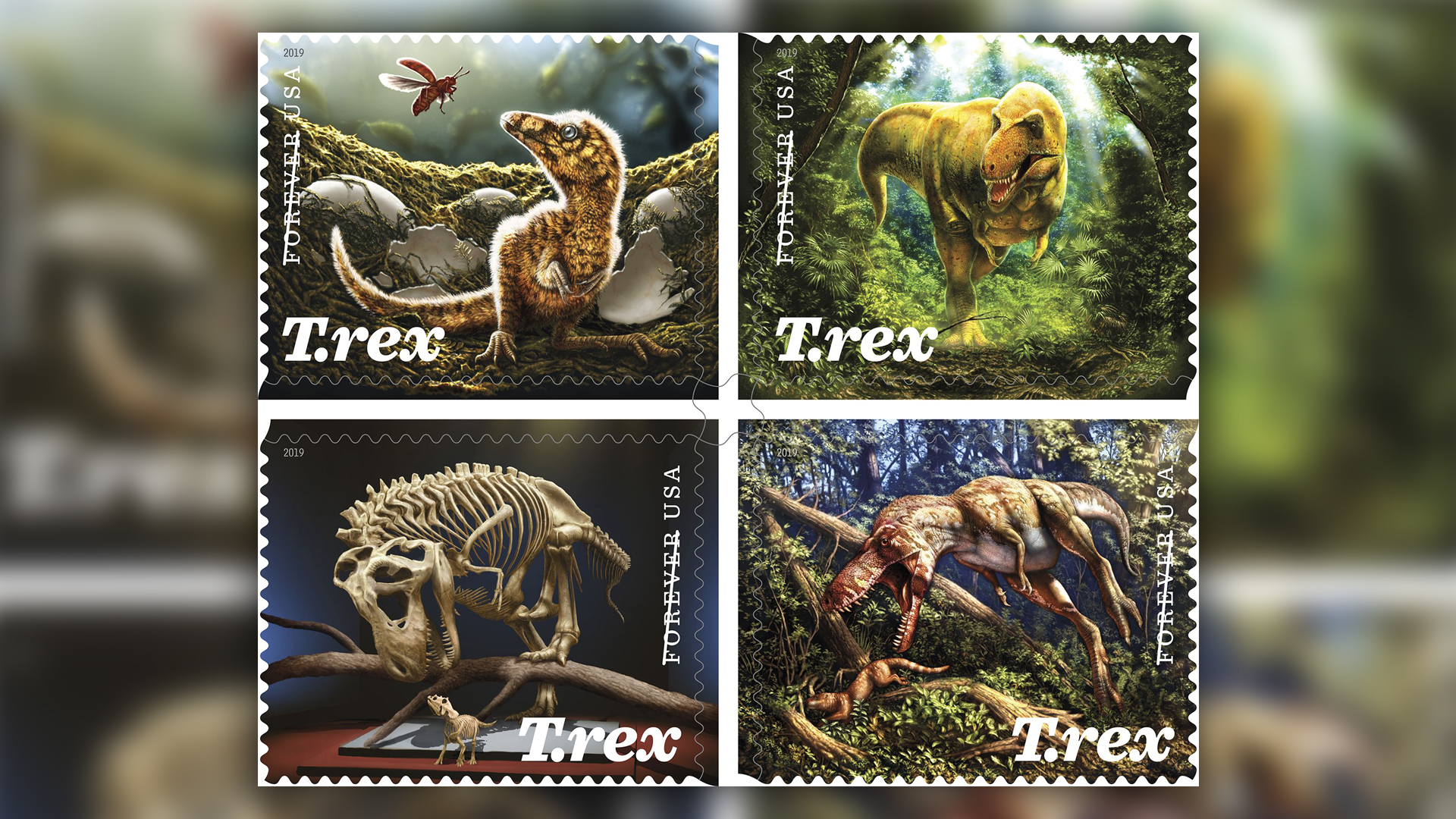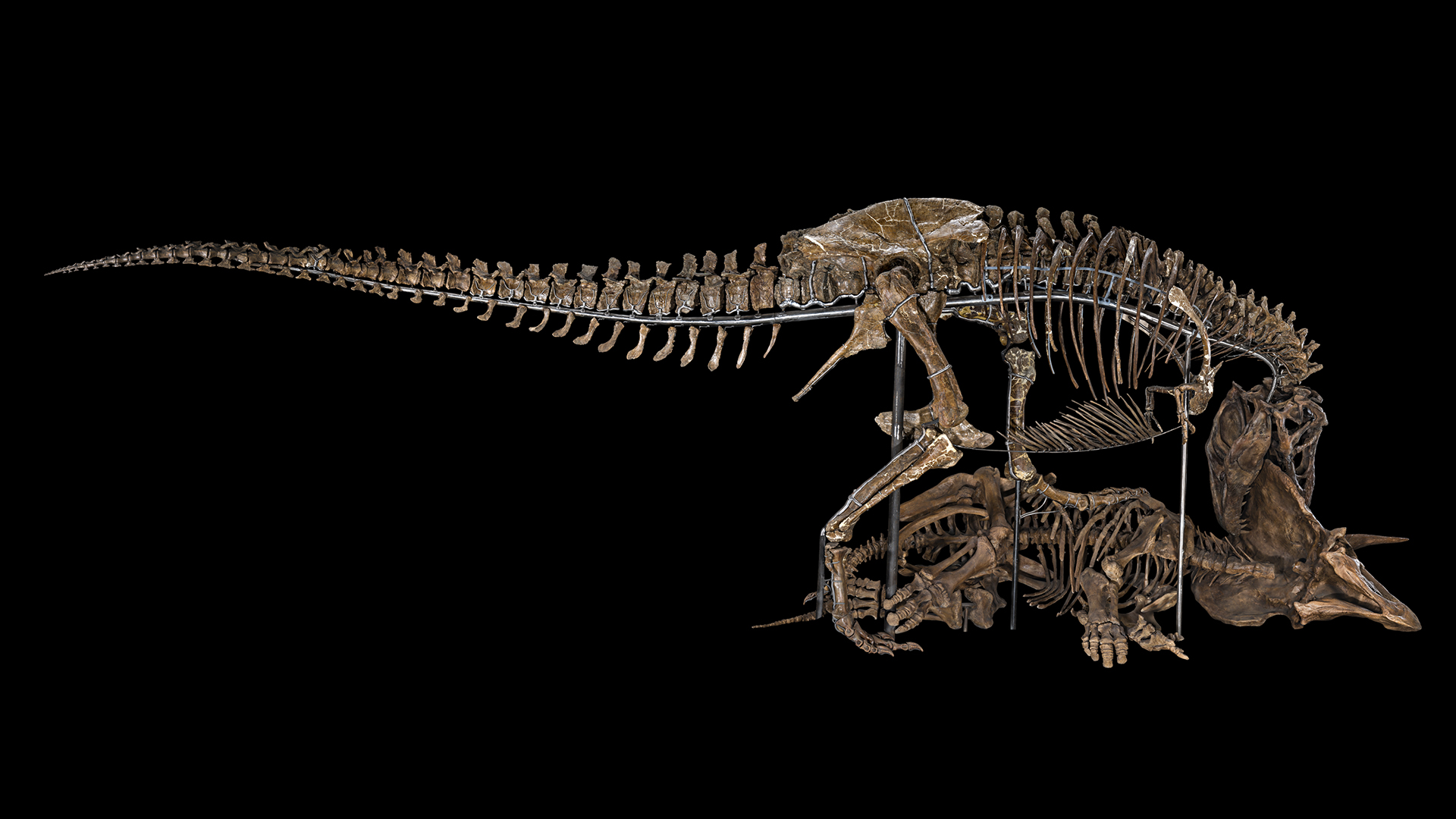Fuzzy Baby T. Rex Is One of 4 New Stamps Featuring the Dinosaur King
The stamps showcase T. rex during various life stages.

The reign of the fearsome dinosaur Tyrannosaurus rex ended around 66 million years ago, but people still can't get enough of the toothsome theropod. And now, thanks to the U.S. Postal Service (USPS) you can attach gorgeously illustrated T. rex scenes to your mail.
On Aug. 29, the USPS will debut a new set of T. rex stamps in a dedication ceremony at the Smithsonian National Museum of Natural History (NMNH) in Washington, D.C., according to a statement.
The stamps feature four colorful views of T. rex. Three of the scenes show T. rex as it may have looked during several stages of its life: as a downy newly-hatched baby, a partly-feathered teenager chasing a primitive mammal, and a muscular adult striding through a Cretaceous forest. In the fourth scene, an articulated adult T. rex skeleton looms over the much smaller skeleton of a young triceratops.
Related: In Images: A New Look at T. Rex and Its Relatives

The skeleton illustration is modeled after a remarkably complete T. rex fossil found in Montana in 1988. Originally installed in the Museum of the Rockies and called the "Wankel T. rex," the 38-foot-long (12-meter) skeleton is now known as "The Nation's T. rex," and has a new home at NMNH. It was unveiled to the public when the museum's newly renovated dinosaur hall — The David H. Koch Hall of Fossils: Deep Time — was reopened on June 7, Reuters reported.
The Nation's T. rex is mounted in a predatory pose, poised over another fossil skeleton: the prone body of an adult triceratops. In the exhibit, T. rex's massive, banana-shaped teeth are clamped firmly on the fallen dinosaur's neck frill.
But the details of that scene would have been difficult to capture in the small frame of a postage stamp, paleoartist Julius Csotonyi told Live Science. Instead, the skeleton stamp shows the enormous carnivore peering down not at an adult triceratops, but at a diminutive baby. Csotonyi created the original artwork for the stamps in collaboration with art director Greg Breeding, according to the USPS statement.
Get the world’s most fascinating discoveries delivered straight to your inbox.
In the art for the endearing hatchling stamp, the baby's downy coat of feathers represents decades of data establishing that feather-like structures were distributed throughout the dinosaur family. Some early tyrannosaurs are known to have had feathers, so it's reasonable to expect that a later tyrannosaur such as T. rex would also have had the genetic capability of generating feathers, even if the adults don't have noticeable feathers on most of their bodies, Csotonyi said.
"We have fossil material showing Tyrannosaurus adults had scales, but that doesn't necessarily refute the possibility of their having feathers on some parts of the body as well," he added.
Designing stamps such as the T. rex series is a process that can take years, USPS representative Roy Betts told Live Science in an email. It begins with members of the public submitting topic suggestions to the Citizens' Stamp Advisory Committee (CSAC); proposals are then reviewed by CSAC members and submitted to the U.S. Postmaster General, who makes the final decision about forthcoming designs, Betts said.
- Baby T. Rex Was an Adorable Ball of Fluff
- Gory Guts: Photos of a T. Rex Autopsy
- Photos: Tiny Tyrannosaur Dinosaur Was About As Big As T. Rex's Skull
Originally published on Live Science.

Mindy Weisberger is a science journalist and author of "Rise of the Zombie Bugs: The Surprising Science of Parasitic Mind-Control" (Hopkins Press). She formerly edited for Scholastic and was a channel editor and senior writer for Live Science. She has reported on general science, covering climate change, paleontology, biology and space. Mindy studied film at Columbia University; prior to LS, she produced, wrote and directed media for the American Museum of Natural History in NYC. Her videos about dinosaurs, astrophysics, biodiversity and evolution appear in museums and science centers worldwide, earning awards such as the CINE Golden Eagle and the Communicator Award of Excellence. Her writing has also appeared in Scientific American, The Washington Post, How It Works Magazine and CNN.
